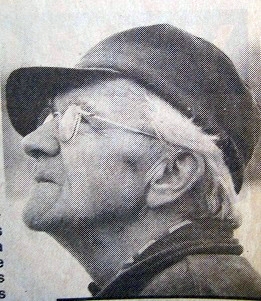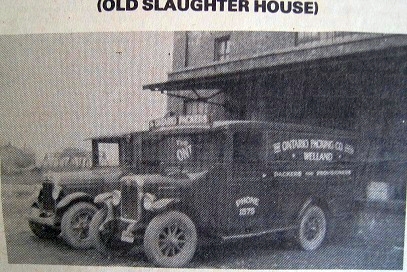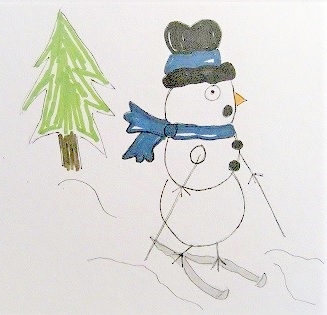DOWN MEMORY LANE
[Welland Tribune: Date Unknown]
 Welland blacksmith, Mike Hogue, learned his trade in Effingham, Ontario, and was apprenticed in 1896, to Mr. Lymburner, whose shop was situated at 15 Niagara Street in Welland, just north of the current Welland House Hotel location.
Welland blacksmith, Mike Hogue, learned his trade in Effingham, Ontario, and was apprenticed in 1896, to Mr. Lymburner, whose shop was situated at 15 Niagara Street in Welland, just north of the current Welland House Hotel location.
In 1907, he purchased the business from Mr.Lymburner and hired Andy Harkness. In late 1929, Mike Hogue purchased property fronting on Fraser Street, just west of his shop, and opened a new business. Lem Hogue, a son, recalls that some of the material for the new shop was salvaged from the old aqueduct on the canal. He also notes that blacksmiths were not always paid in currency. Often payment was in kind-a bag of potatoes, a ham, or a pair of piglets. The last horse shoed by the Hogues was in 1954. The original anvil is on exhibit at the Welland Historical Museum.
In 1956, the shop and property were sold to the Oddfellows organization, the members of which apparently had great difficulty in removing large amounts of soot from the facility.
(OLD SLAUGHTER HOUSE)
By David l. Blazetich, from the files of his grandfather George “Udy” Blazetich
[Date Unknown]

A long time ago, the residents of 7th Street, in Crowland, were often disturbed by the unpleasant sounds and smells emanating from the Ontario Packing Plant, affectionately referred to as “The Old Slaughter House”. One consolation, however, was that the neighborhood could purchase fresh meat at cost price on the slaughter house premises.
The Ontario Packing Plant was opened on August 19th, 1922 with Frank Ahman as its president. Among the first employees, brought in from Kitchener, were many Senior A hockey players including well-known Art Barlett of the Kitchener-Waterloo Dutchmen.
The Old Slaughter House later became the home of Stan Reid’s used automobile dealership and, still later, Sunnyside Dairy, which is still owned and operated by Al lan Pietz, M.L.A.
lan Pietz, M.L.A.
In the accompanying photographs, note in the background the swing bridge (Black Bridge) at the foot of Sixth Street, and the McCabe House, the subject of a previous article by this writer.
*Note also the present owner of Sunnyside Dairy as depicted in 1954 with his father, Deputy Reeve Paul Pietz of Humberstone Township, Warden in 1952. At that time, his son, Deputy Reeve Allan Pietz at 24, was the youngest man ever to serve on Welland County Council. They were the first father and son combination in the history of Welland County Council.

Christmas is gone so what can we folks do
The hours of sunshine each day are very few
Some days we look out and the sky is all grey
So we stay in with a new game we learn to play
Others may go to a warm southern destination
While the rest of us stay in this cold frozen nation
Puzzles of all kinds some folks do each day
As they know it helps to pass the time away
And others read books to see what they can learn
Since its for the true story they always yearn
While some write a poem or letter by the fireplace
To a friend or a relative as they can’t see their face
Others feel its best to call a friend on the phone
As some may not know they are alone in their house
And movies will be watched with the heat turned on
While they wait again for the cold weather to be gone
Older folks will knit some socks or a hat
And if tough times loom we’ll all do more of that
We’ll have snowmobiles as they go down the trail
So I pray they’ll get home safely without fail
Snowshoes aren’t used much like they were years ago
As they were the only way then to get over the snow
The lake can be cleared and folks can have a skate
While children can feed birds and a snowman make
And others can go skiing which may give them a thrill
Or ride a toboggan once again down a snowy hill
Let covid be gone or again we’ll all be found
At home with our family in another lockdown.
Winston E. Ralph
Bancroft, ON
SOME WINTERTIME AMUSEMENTS
Christmas is gone so what can we folks do
The hours of sunshine each day are very few
Some days we look out and the sky is all grey
So we stay in with a new game we learn to play
Others may go to a warm southern destination
While the rest of us stay in this cold frozen nation
Puzzles of all kinds some folks do each day
As they know it helps to pass the time away
And others read books to see what they can learn
Since its for the true story they always yearn
While some write a poem or letter by the fireplace
To a friend or a relative as they can’t see their face
Others feel its best to call a friend on the phone
As some may not know they are alone in their house
And movies will be watched with the heat turned on
While they wait again for the cold weather to be gone
Older folks will knit some socks or a hat
And if tough times loom we’ll all do more of that
We’ll have snowmobiles as they go down the trail
So I pray they’ll get home safely without fail
Snowshoes aren’t used much like they were years ago
As they were the only way then to get over the snow
The lake can be cleared and folks can have a skate
While children can feed birds and a snowman make
And others can go skiing which may give them a thrill
Or ride a toboggan once again down a snowy hill
Let covid be gone or again we’ll all be found
At home with our family in another lockdown.
Winston E. Ralph
Bancroft, ON
By Guardian Writer
TIM BYNG
Date Unknown
Ontario Heritage Act-8 November 1986
One of Welland’s most historic buildings has been approved by Welland city council for heritage designation.
The Fortner House, now known as Rinderlin’s Dining Rooms, at 24 Burgar St., has been recommended for heritage designation by the city’s Local Architectural Conservation Advisory Committee (LACAC).
Betty Ann DiMartle, LACAC chairman, told city council last week the property was considered for designation through research carried out in the summer of 1984 with the assistance of students employed under a Canada Summer Works grant.
The research indicates that the property and structure is deemed to have sufficient architectural and historical significance to the city to be designated as a heritage property.
City council approved the processing of the structure for heritage designation under the Ontario Heritage Act.
DiMartle outlined the history of the structure to city council.
PURCHASED 1835
In 1835 the lands, which are adjacent to what is now the corner of East Main and Burgar Streets, was purchased by Thomas Burgar, the first postmaster for the Village of Welland.
Burgar Street, in all likelihood, was named after the Burgar family.
Burgar had a plan registered in 1855, dividing a portion of his holdings for sub-division purposes.
The lots were sold to George H. Burgar, the son of Thomas Burgar, in 1859. Based on available records, it is believed the house was erected on this property in 1859.
George Burgar was a carpenter by trade and was very active in local politics. He was an alderman for 19 years between 1871 and 1912. As well, he was mayor of the Town of Welland and in 1893 and 1894. In 1874, he succeeded his father as postmaster.
In 1868, Burgar sold the house and property to Jonathan S. Chipman. In the same year, Dr. W.E. Burgar, son of George R.E. Burgar, began his medical practice out of the house.
Several land transactions took place over the next several years. In 1875, John McDonald and others, sold the property to Mary L Burgar, the wife of Dr. W.E. Burgar.
During that period or ownership, in 1884, a large addition was made to the original house.
In 1888, a prominent citizen, Dr. Sinclair H. Glasgow, married Nancy Fortner, who had two daughters, by a previous marriage, Gertrude Maude and Theo. The following year, Nancy C. Glasgow purchased the property.
Dr. Glasgow was an alderman for the Town of Welland in 1891 and mayor in 1895 and 1896, and was the medical officer of health for Crowland.
In 1922, the property, which was to become known as the Fortner house, came under the ownership of the two Fortner sisters. The last sister, Gertrude Maude, died in 1970 and the original furnishings were auctioned off and the property put up for sale.** The last sister to pass was Theo Graham Fortner: 1881-1970. Gertrude Maude: 1879-1968.
RINDERLINS
During the next decade, there were several owners, and uses made of the property. In 1980, Emil Rinderlin purchased the property, renovated the house, and in 1981, opened up Rinderlin’s Dining Rooms.
“Mr. Rinderlin has undertaken extensive renovations to ensure that as much of the original structure as possible has been maintained,” the report said.
The three storey frame structure is an excellent example of the Queen Anne Revival Style probably the result of the major addition constructed in 1884.
This style was a result of a design period which “revolted at the rigid rules of classical architecture,” according to the LACAC. Report. The house is characteristic of the Queen Anne Revival Style by its “asymmetrical composition and whimsical detail which is evident in its turret, window gables, dormers, porches and balconies.”
This period also exploited fine materials in a “creative off-beat manner.” This is obvious in the original finishes of fine wood, unusual mouldings, panels and a handsome stairway.
Other significant adornments include a spindle tracery offset over the fireplace, a curved glass window and mirror at the front entrance, which at one time allowed a clear southern view down Burgar Street. The unusual half circle motif of the stair balustrades, which appear to be a fine cherry or mahogany, “would be typical of this period,” the report stated.
 Welland blacksmith, Mike Hogue, learned his trade in Effingham, Ontario, and was apprenticed in 1896, to Mr. Lymburner, whose shop was situated at 15 Niagara Street in Welland, just north of the current Welland House Hotel location.
Welland blacksmith, Mike Hogue, learned his trade in Effingham, Ontario, and was apprenticed in 1896, to Mr. Lymburner, whose shop was situated at 15 Niagara Street in Welland, just north of the current Welland House Hotel location. Subscribe..
Subscribe..

 lan Pietz, M.L.A.
lan Pietz, M.L.A.